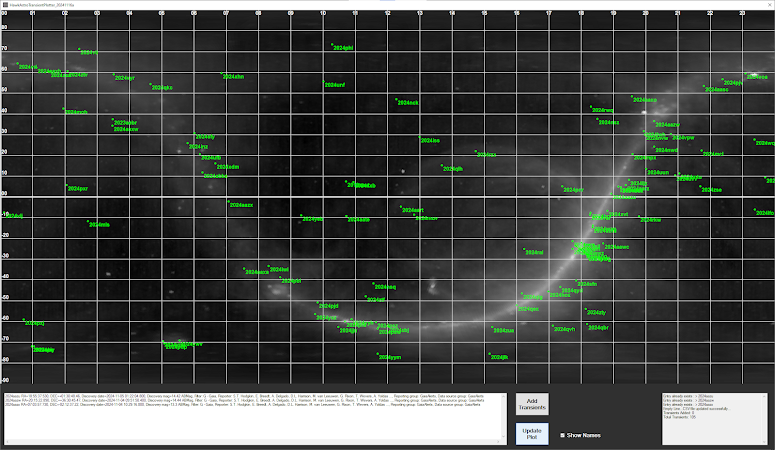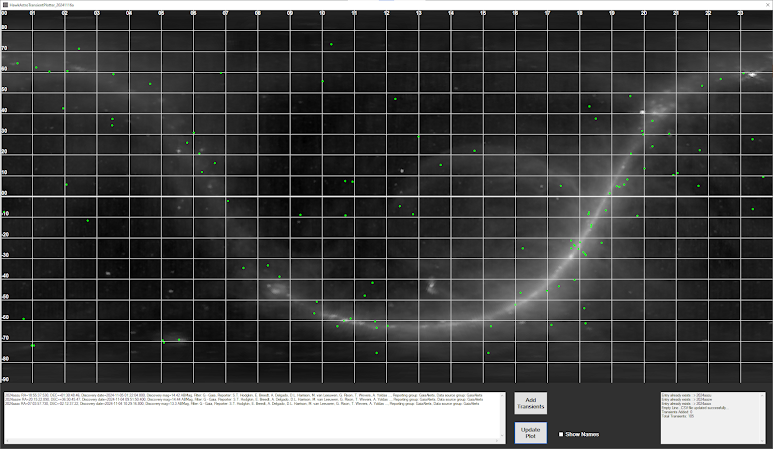Astronomical transients have always been of special interest - the radio astronomy Vela pulsar observations searching for 'glitches' were motivated by this. Now activities have migrated over to optical astronomy and that interest in transients remain.
A subscription (free) to email alerts from the Transient Name Server (TNS) was made and alerts come in this format in an email...
The following new transient/s were reported on during the last day:
2024aazu RA=18:55:37.530, DEC=+01:30:48.46, Discovery date=2024-11-05 01:22:04.800, Discovery mag=14.42 ABMag, Filter: G - Gaia, Reporter: S.T. Hodgkin, E. Breedt, A. Delgado, D.L. Harrison, M. van Leeuwen, G. Rixon, T. Wevers, A. Yoldas ..., Reporting group: GaiaAlerts, Data source group: GaiaAlerts
2024aazw RA=20:15:22.890, DEC=+36:30:45.47, Discovery date=2024-11-04 09:51:50.400, Discovery mag=14.44 ABMag, Filter: G - Gaia, Reporter: S.T. Hodgkin, E. Breedt, A. Delgado, D.L. Harrison, M. van Leeuwen, G. Rixon, T. Wevers, A. Yoldas ..., Reporting group: GaiaAlerts, Data source group: GaiaAlerts
2024aazx RA=07:03:57.730, DEC=-02:12:37.22, Discovery date=2024-11-04 10:29:16.800, Discovery mag=13.3 ABMag, Filter: G - Gaia, Reporter: S.T. Hodgkin, E. Breedt, A. Delgado, D.L. Harrison, M. van Leeuwen, G. Rixon, T. Wevers, A. Yoldas ..., Reporting group: GaiaAlerts, Data source group: GaiaAlerts
The alert comes with the transient's ID, RA/DEC coordinates, discovery time, discovery magnitude, followed by other information.
Curiosity about the distribution of transients provided the motivation to code a rough plotting application (C# Windows GUI) which would accept a cut-and-paste of the transient/s information lines and parse them into names and RA/DEC coordinates. The application then plots them on a RA/DEC graph which has a Hydrogen Line image as the background (which provides a guide to the position of the Milky Way).
As new transient alerts arrive they can be added to the list and the plot updated to show the new entries.
An example result is shown below...
 |
| Typical Plot (~100 transients) with Names Shown |
As can be seen as the number of transients increase there is confusion due to the names overlapping. An option to only plot the points is provided as shown below...
 |
| Typical Plot Without Names |
As would be expected the highest density is near the Galactic Centre, but interestingly this density is - so far - not overwhelming higher than elsewhere.
It will be interesting to see how the plotting progresses over time as new transients are added.
Some extra functions may be added at a later date. For example - display only the newest object or objects for the purpose of seeing whether they can be seen in the Seestar S50.
NOTE: The TNS alerts come from telescopes which monitor a very large area of the sky. The likelihood of an amateur telescope with limited FOV discovering a transient are vanishingly small. Of course it is possible - but the likelihood of beating the professional observations is not great.









